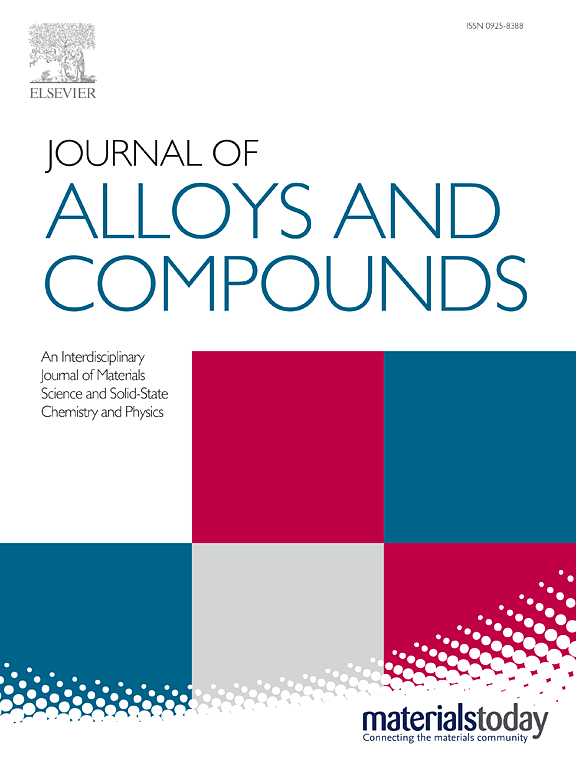通过在等轴晶中加入网状子结构,激光沉积钛合金实现了良好的强度-塑性结合和各向异性消除
IF 5.8
2区 材料科学
Q2 CHEMISTRY, PHYSICAL
引用次数: 0
摘要
与只能在特定温度和应力范围内有效工作的单一均匀钛合金相比,梯度钛合金可以在更大的温度和应力范围内表现出优异的性能。制备梯度钛合金的一种有效方法是将增材制造与锻造相结合,将金属粉末直接沉积在锻造板上。然而,在消除激光沉积钛合金各向异性的同时实现良好的强度-塑性组合仍然是一个重大的挑战。为了缓解不同合金在梯度组分界面处的性能失配,采用激光沉积的方法在锻造钛合金基体上沉积了不同比例的近α钛合金和Ti2AlNb合金的预混合粉末作为过渡层。系统地研究了沉积态混合钛合金粉末试样在水平(扫描)和垂直(构建)方向上的显微组织和拉伸行为。结果表明:含50 wt.%近α钛合金和50 wt.% Ti2AlNb的激光沉积混合钛合金粉末在等轴β/B2晶粒内形成了丰富且连续的网状亚结构,其特征为密集且平行排列的α2相团簇,有利于实现强度(1007.63 MPa)和塑性(8.19%)的良好结合,消除各向异性;网状亚结构沉积试样的强化作用主要是晶粒细化和位错强化,而非固溶强化。此外,各向同性强度和延性的实现还归因于在垂直和水平方向上具有相似体积分数和分布的特殊网络子结构,这减少了施密德因子的分布差异,促进了更均匀的变形行为。本文章由计算机程序翻译,如有差异,请以英文原文为准。
Achieving well strength-ductility combination and anisotropy elimination in laser deposited titanium alloy by incorporating network substructures within equiaxed grains
Gradient titanium alloys can exhibit excellent performance over a wider range of temperatures and stresses, compared with single homogeneous titanium alloys that can only work effectively within specific temperature and stress ranges. An effective approach for the preparation of gradient titanium alloys involves combining additive manufacturing with forging, where metallic powders are deposited directly onto a forged plate. However, achieving a good strength-ductility combination while eliminating anisotropy in laser deposited titanium alloys remains a significant challenge. To mitigate the performance mismatch at the interface between dissimilar alloys in gradient components, premixed powders of near-α titanium alloy and Ti2AlNb alloy at different proportions were deposited as a transition layer on the forged titanium alloy substrate by laser deposition in the present work. The microstructure and tensile behavior of the as-deposited mixed titanium alloy powders samples along the horizontal (scanning) and vertical (building) directions were systematically investigated. The results showed that abundant and continuous network substructures characterized by densely and parallelly arranged α2 phase clusters were formed within equiaxed β/B2 grains of the laser deposited mixed titanium alloy powders containing 50 wt.% near-α titanium alloy and 50 wt.% Ti2AlNb, which are conducive to achieving a favorable combination of strength (1007.63 MPa) and ductility (8.19%), as well as the elimination of anisotropy. The strengthening contribution of the as-deposited sample with network substructures was primarily attributed to grain refinement and dislocation strengthening, rather than solid solution strengthening. Additionally, the achievement of isotropic strength and ductility was ascribed to the special network substructures with a similar volume fraction and distribution at both vertical and horizontal directions, which reduce the distribution difference in Schmid factor and promote more uniform deformation behavior.
求助全文
通过发布文献求助,成功后即可免费获取论文全文。
去求助
来源期刊

Journal of Alloys and Compounds
工程技术-材料科学:综合
CiteScore
11.10
自引率
14.50%
发文量
5146
审稿时长
67 days
期刊介绍:
The Journal of Alloys and Compounds is intended to serve as an international medium for the publication of work on solid materials comprising compounds as well as alloys. Its great strength lies in the diversity of discipline which it encompasses, drawing together results from materials science, solid-state chemistry and physics.
 求助内容:
求助内容: 应助结果提醒方式:
应助结果提醒方式:


